Basketball
This is an excerpt from Effective Physical Education Content and Instruction With Web Resource by Phillip Ward,Harry Lehwald.
Basketball is the second most popular sport in the world, and it is played in more than 200 countries. In the United States, the home of basketball, it is a staple of many physical education programs in elementary, middle, and high schools. It is also becoming more popular in the physical education curricula in other countries. Research conducted in the United States shows that basketball is among the top four activities (after camping, swimming, and biking) that nonparticipants in physical activity aged 6 to 12 years would like to learn (Physical Activity Council, 2016). Although basketball is common in the U.S. school curriculum, research shows that it is one of the least-liked sports among U.S. students aged 5 to 17 years (Bailey, Hillman, Arent, & Petipas, 2013; Rikard & Baneville, 2006). What is the reason for this seeming contradiction? We propose that students dislike basketball in physical education because it is often taught in ways that do not help them develop skillfulness and game sense. Failure to develop these aspects hinders children from pursuing basketball and enjoying the game. We have designed this chapter to ensure that skillfulness and game sense are progressively taught and that the organization and use of pedagogies ensure that students have frequent opportunities to learn in every lesson.
Our Pedagogical Approach to Basketball
Basketball is a small-sided court invasion game. Instruction in the elementary and secondary units focuses on developing skillful performance and game sense through tasks and instructional sequences that teach basketball skills and quickly using these skills in modified games.
Developing skillful performance involves the basic offensive techniques of shooting, passing, and dribbling. Because dribbling is challenging, we focus on passing and shooting performance with beginners and introduce dribbling in tasks and during the warm-up. Once students develop dribbling skills, these are incorporated into the tasks and game play as part of the triple-threat (pass, dribble, or shoot) decision-making process.
We begin with person-to-person defensive principles. We do not add zone defense until late in the learning sequence, because effective zones are founded on person-to-person principles.
We use modified games that emphasize passing in level 1, 3v3 half-court games in level 2, and 4v4 full-court games in level 3. We use overload games (e.g., 2v1, 3v2) to develop game sense because they can be used to emphasize specific elements such as dribbling and shooting in game-like conditions. Overload games increase student engagement and allow for greater student success as they apply the learned techniques. We use the PAC progression when adding defensive pressure. See chapter 7 for a detailed description of the PAC progression.
Modifications to Address Individual Needs of Students
For students with disabilities, appropriate modifications depend on the nature of the disability. To modify basketball instruction for students with visual impairments, you can (a) use brightly colored basketballs (e.g., bright orange or yellow), (b) use brightly colored floor tape to mark off boundaries, or (c) use tactile modeling when demonstrating the proper form for various basketball skills.
For students with autism spectrum disorder, set up groups that practice in quieter or less chaotic areas of the gymnasium. You can also present materials using the students' desired communication methods (e.g., using picture symbols).
For students who use wheelchairs, adopt rules from wheelchair basketball. Rather than holding students to the same dribbling technicalities, introduce and enforce wheelchair basketball dribbling rules (e.g., students are not allowed to take more than two consecutive pushes without bouncing a ball).
For individuals with cerebral palsy, you may need to limit the speed at which students move between locations. To accommodate this, consider decreasing the playing area (e.g., playing half-court) and teaching zone defense so each student defends only a small area within the court.
Organization
A full-sided basketball game is 5v5. We question the appropriateness of 5v5 in a physical education setting relative to teaching beginners. The development of game sense in basketball is based on three general game tactics: on-the-ball play, off-the-ball play, and opposite-the-ball play. When these are taught to beginners in a 5v5 setting, the fifth student (and to a lesser extent the fourth student) congests the midcourt and limits students' abilities to apply the techniques and tactics being learned. As such, we advocate the use of a 3v3 team structure with beginners to develop the skillful play and game sense needed for basketball. We don't recommended adding the fourth student until students can somewhat successfully apply the elements of skillful play and game sense they have learned. We do not recommend that you use a 5v5 game in a typical physical education setting.
Space
We recommend that you have one basketball court and at least 4 to 6 baskets. At the elementary level, when equipment might be limited, we suggest detachable baskets with suction cups or targets that are attached to the wall (students strike the targets with the ball). If fixed baskets are available, they should be adjustable down to 6 or 8 feet (1.8 to 2.4 meters) for elementary and middle school students. Adjustable goals are also preferred at the high school level, but this is not mandatory. The court space should be large enough to be divided into home areas for groups of 4 to 8 students, and you should have enough goals to accommodate each group of students. If you use an outdoor space, a wall is helpful for some tasks.
Equipment Needed
Having a variety of basketballs sizes (e.g., 4, 5, 6) is important at the elementary level regardless of skill level. Balls must be scaled to the students' hands. At the middle and high school levels, basketball sizes 6 (intermediate) and 7 (official) need to be available. You should have enough balls for each student.
Content Map Structure
Figure 8.1 is a combined content map that illustrates the flow and connectedness of all the tasks used to develop skillful play and game sense in basketball. It is divided into three levels, and each level has a separate content map that includes the application games used to refine the elements of skillful play and game sense at that level. Although dribbling is introduced in level 1 (figure 8.2), the primary focus is on passing and shooting, and it ends with an application game that combines those two techniques. At level 2 (figure 8.3), dribbling, defense, and individual offensive tactics are added, and the end game is a 3v3 game. At level 3 (figure 8.4), offensive and defensive tactics are stressed; this level ends in a 4v4 game.
In the content maps, we have numbered the tasks. These numbers are used to cross reference tasks descriptions in the body of the chapter with the content maps. The task numbers should not be interpreted as the order in which they should be taught. It is important that tasks are taught and progressed from simpler to more complex forms which is shown in the upward progress of the task sequence on the content map. This is particularly necessary before tasks are combined. For instance in basketball whether you teach shooting first or dribbling, the progressions of both need to be taught before they are combined in task 19.
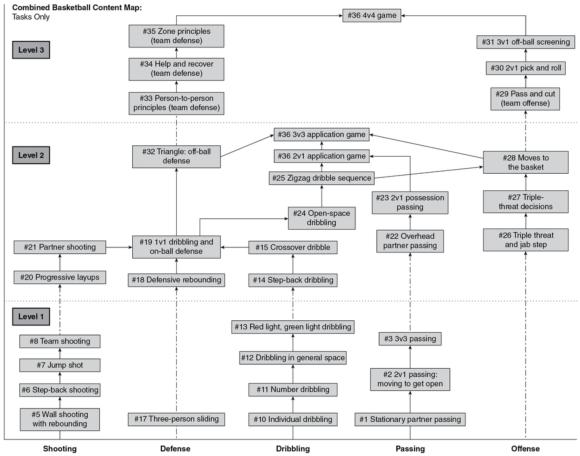
Combined content map for basketball.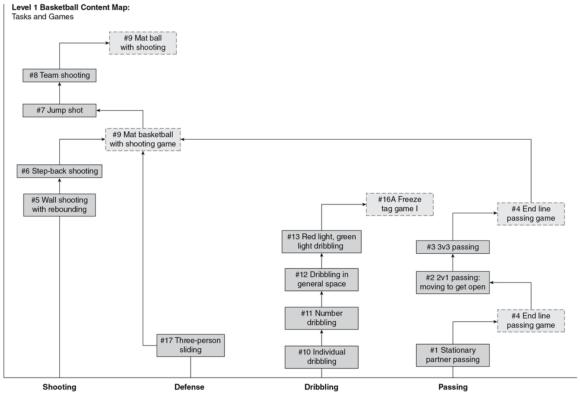
Level 1 content map for basketball.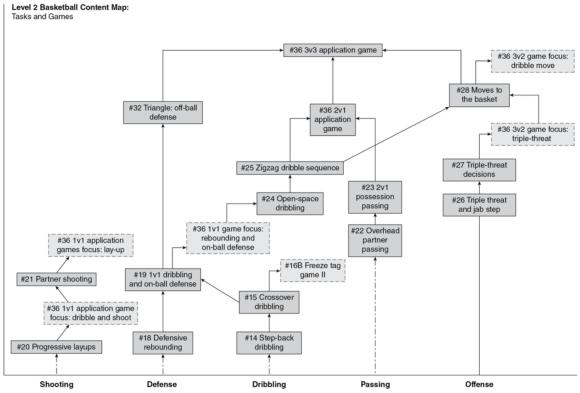
Level 2 content map for basketball.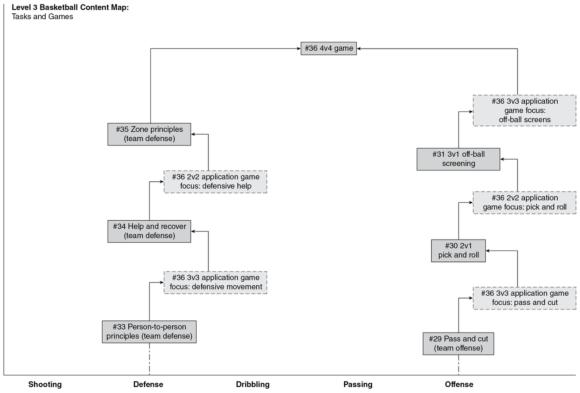
Level 3 content map for basketball.
Structure of the Lessons
The following is a sample daily lesson structure for a 50-minute elementary basketball lesson.
- Warm-up (5 to 6 minutes)
- Application game: end line passing game (5 to 6 minutes)
- Informing task: 2v1 passing (5 minutes)
- Extension task: 2v1 passing from the other side (4 minutes)
- Extension task: PAC defense applied to the 2v1 passing task (5 minutes)
- Informing task: individual dribbling (5 minutes)
- Extension task: nondominant side dribbling (4 minutes)
- Application game: mat basketball with shooting game (10 minutes)
- Closure (3 to 5 minutes)
Warm-up
Elementary School
The warm-up should be taught to students on the first or second day of the unit. If a technique used in the warm-up has not been taught, it should not be included in the warm-up circuit until the day after you teach it. Passing, dribbling, and shooting are the initial techniques used in the warm-up. In the first lesson, passing and wall shots are introduced; therefore, you can include passing and shooting practice in the warm-up for lesson 2. Lesson 2 introduces individual dribbling, so you can include that technique in the warm-up for lesson 3. Each day you can add new techniques, such as step back shots for wall shots (see the five-day block plan), or you can stick with the same warm-up.
For the passing task, pairs of students stand 8 to 10 feet (2.4 to 3 meters) apart and pass the ball back and forth using the techniques that have been taught. For the shooting task, students begin with wall shots and move to step-back shots with a partner after a couple of days. For the dribbling task, students dribble in a stationary position using the dominant and nondominant hands. After a couple days, students can add movement to the dribbling if their skills have progressed appropriately. The warm-up time should allow for multiple trials. Once students have learned the warm-up, it should not last more than 5 to 6 minutes.
How you organize your students for the warm-up will depend on the decisions you make about the organization of the class.If you use a circuit, divide the class into three groups and include the appropriate equipment at each of the three stations (see figure 8.5). The passing and shooting stations require basketballs for each pair of students, and the dribbling station requires a ball for each student. Students should begin each day in the same area and rotate through the stations. The tasks can be done in any order. Provide instructions for what students should do once they have completed all the stations. If you decide to have the whole class do the warm-up activities together, you need to have enough baskets to accommodate the entire class with no more than 8 students at a basket. You can add stick-on baskets to the walls if needed. We recommend that the warm-up not last more than 5-6 minutes once it has been learned.

Sample elementary school warm-up circuit for basketball.
Secondary School
Teach the warm-up in lessons 2 through 4; once students know the warm-up, it should take 4 to 5 minutes. Students work in pairs. In the first task, students alternate between open-space and close-control dribbling in the court space. Each pair has a ball, and one student assumes the role of offense and the other assumes the role of defense. The defensive student moves along with the offensive student and provides active defense as the offensive student dribbles under control. Students switch roles after each trial. In the next task, students practice left- and right-handed layups; one student shoots and the other student rebounds. After rebounding, the rebounder moves to the shooting line and the shooter moves to the rebounding line. After a determined number of right-handed layups, have students attempt left-handed layups. In the last task, students practice open shooting and attempt shots they would take in a game situation. If a student makes a shot, the partner returns the ball and the student continues shooting until a shot is missed or a set number of shots have been attempted; then, the partner becomes the shooter.
This warm-up can be done with stations or in teams. If you use stations, divide the class into three groups and have each group spend about 90 seconds at each station. The lay-ups should be done at one end basket, the open shooting at the opposite end basket with the open- and closed-space dribbling occurring in the middle of the court (see figure 8.6). If the warm-up is done in teams, have groups of 6 to 8 students complete each part of the warm-up in the home area. This requires one basket for each group. Provide students with instructions for what they should do once they finish the warm-up (e.g., put balls away, ball rake, sit down in an assigned space, line up, repeat tasks).
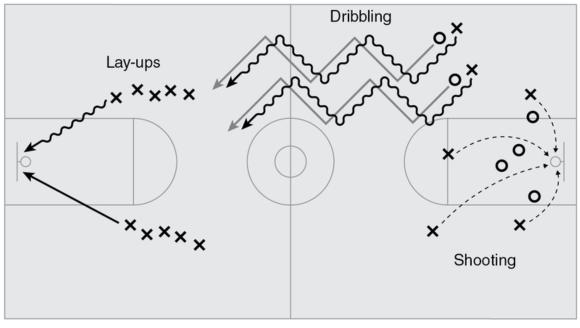
Sample secondary school warm-up circuit for basketball stations.
Block Plan
The introductory block plan is designed for beginners. In elementary school, this should not be introduced earlier than fourth grade. This allows students to refine their basic ball-handling techniques in other activities prior to facing the challenges of manipulating a basketball. Although longer units are always preferred, we recognize that there are time limitations at the elementary level; therefore, the elementary unit is five days for the initial grade in which it is taught.
The secondary block plan follows the elementary block plan and is designed for students in middle school and high school. It assumes that students were taught the basic basketball techniques at the elementary level. If this is not the case, follow the introductory block plan. Because middle and high school physical education programs have different requirements, these units should not be taught in fewer than 10 days. These units are adjusted for 10-, 15-, and 20-day programs, although we recommend units of 20 or more days.

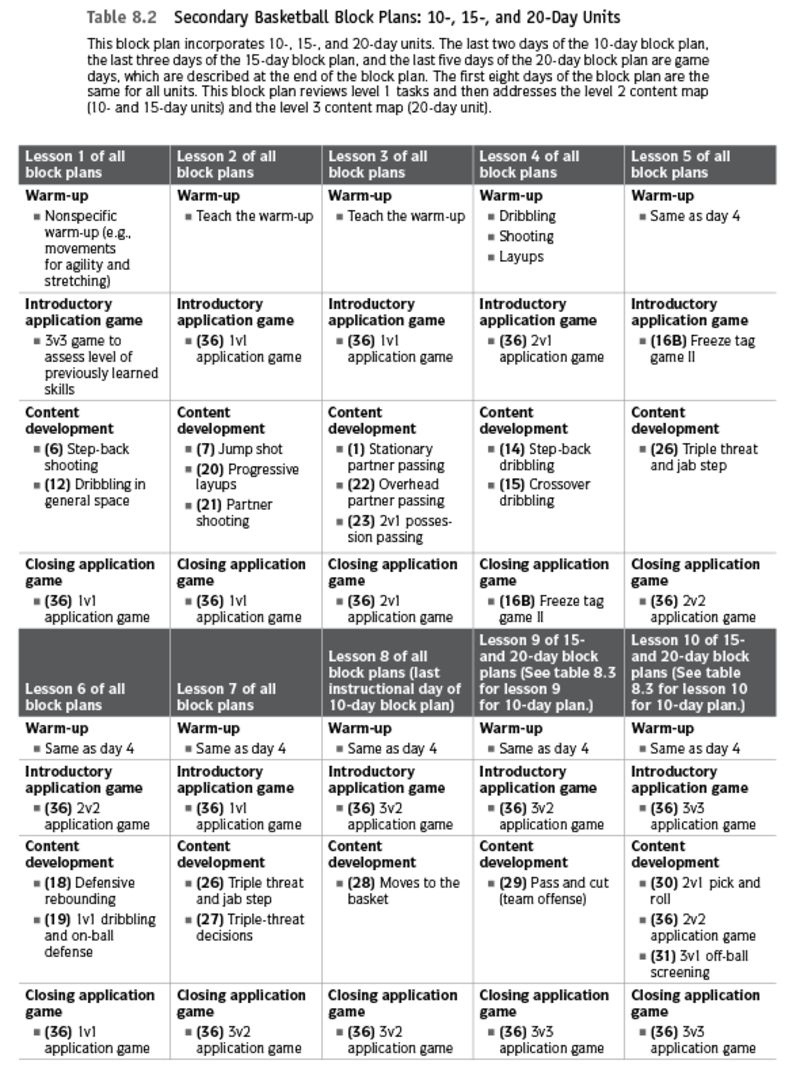
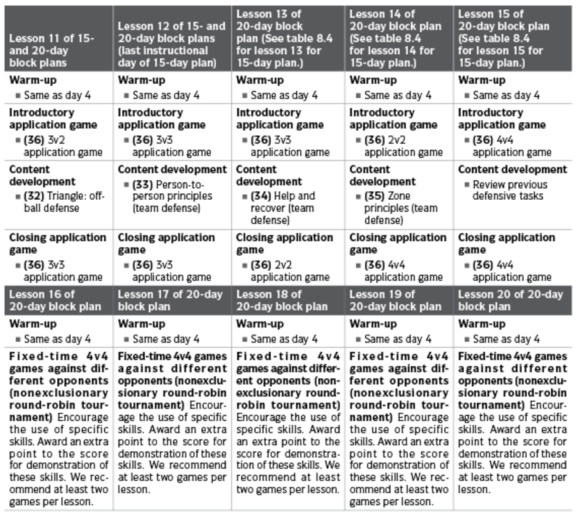


SHAPE America's Grade-Level Outcomes for K-12 Physical Education
In table 8.5, we identify key grade-level outcomes for basketball for 2nd through 8th grade.These are linked to specific tasks on the content maps that are appropriate for teaching the skill and assessing the outcome.
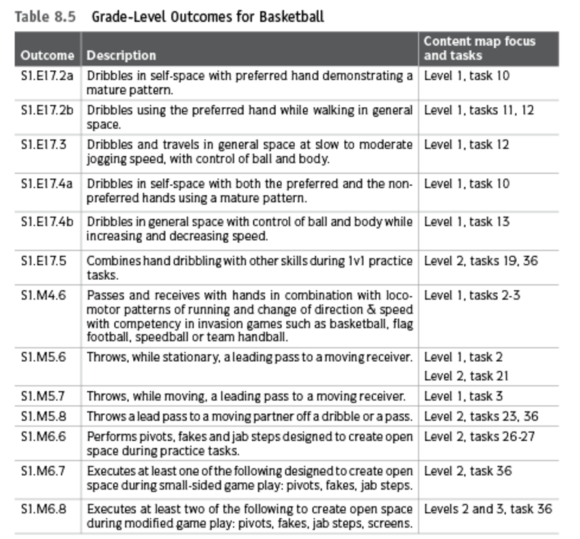
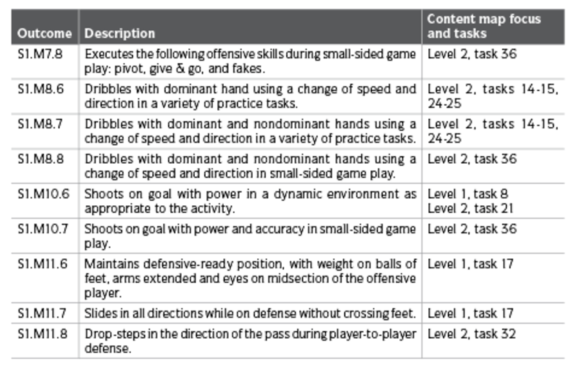
Learn more about Effective Physical Education Content and Instruction With Web Resource.
More Excerpts From Effective Physical Education Content and Instruction With Web ResourceSHOP

Get the latest insights with regular newsletters, plus periodic product information and special insider offers.
JOIN NOW


